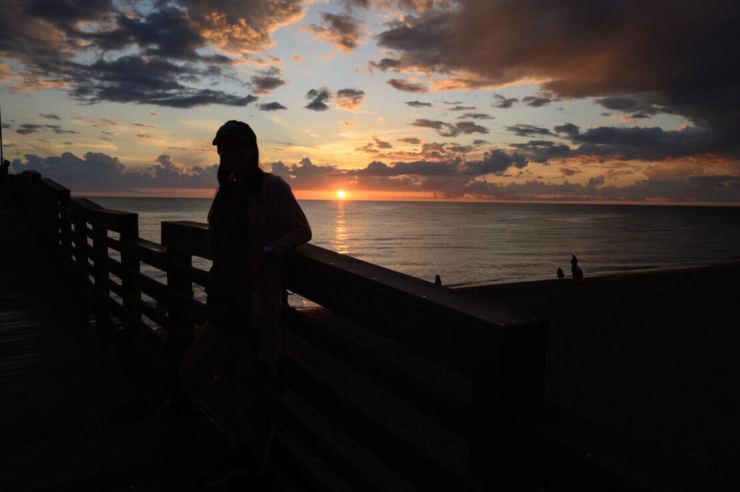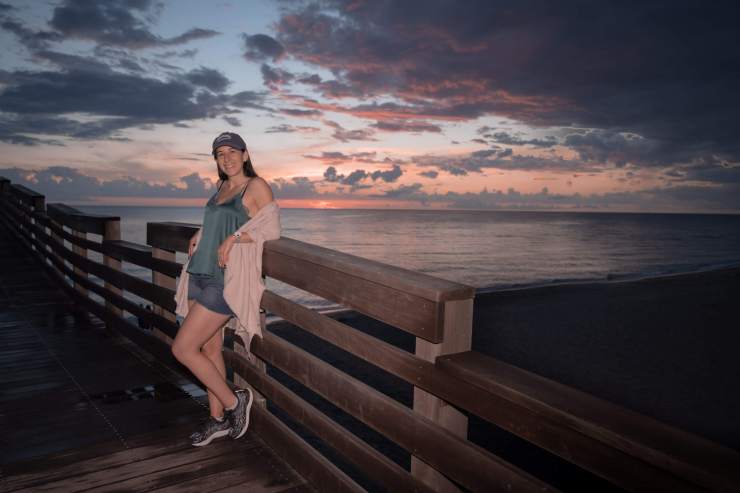Living down in Florida, Mother Nature puts on a show at sunset almost daily. Big puffy clouds with reds, pinks and oranges make a beautiful backdrop against the teal water. This makes sunset at the beach one of my favorite places to take a portrait. To me, there is no more beautiful background.
Sunset does come with a particular set of challenges though. To expose properly for the sky, your subject will be too dark. Expose for the subject and your sky will be over exposed.
The best way to overcome this is with flash. I know a lot of camera enthusiasts are a little uncomfortable with their flash skills, so I am going to give you a method that is super easy. It is called the “AS IF” method.
AS IF
AS IF stands for Aperture, Shutter Speed, ISO and Flash.
The first thing you will need is a flash for your camera. My favorite flash is the Westcott FJ80 but any should do. I prefer the Westcott FJ80 because it is solid, has a round flash head, has colored gels, and is compatible with Canon, Nikon, Sony (with adapter), Fuji, Panasonic Lumix and Olympus. Meaning if you have a Nikon and a Canon (or other listed) camera, you need only buy one FJ80.
While this method works with both on and off camera flash, in this article we will assume you are using on camera flash to keep it simple.
The first step is to put your camera into manual mode. Make sure Auto ISO is set to off as well. This is where the AS IF method comes into play.
The A
First set your aperture on your camera (the A is AS IF). Set this based on your creative vision. If you want a soft background set it to a wide aperture (like f/2.8). What more a more defined background, choose a smaller aperture like f/11. I prefer somewhere close to f/5.6 as I feel it works really well when photographing people.
The S
Next, set your shutter speed (the S in AS IF) so that the background is properly exposed (not the subject). The shutter speed may change during the sunset but somewhere in the range of 1/100s to 1/200s should be good. Do not go over 1/250s if possible, as most cameras require high speed sync for flash at that point. While the FJ80 has high speed sync built in, using it will reduce the flash power and drain the battery.

The I
Now you will set your ISO (the I in AS IF). Make sure auto ISO is off. Remember, you want a perfect exposure of the sky. Use your in-camera meter to make sure everything is exposed correctly.
The F
Finally, you add in the flash. You guessed it, the F in AS IF. Your flash should be on manual mode as well. Place the orange gel on your flash to match the colors in the sky with the light on your subject.

Start at a medium power setting and take a photo. If your subject is to dark, increase the flash power. Too bright, lower the flash power. Once you have the flash power dialed in, now it should just be a matter of adjusting the ISO for the background as it gets darker. If all is set correctly, and assuming you stay the same distance from your subject, you should not have to adjust the aperture, shutter or flash power.
If you move closer or further away from your subject, then adjust your flash power as needed.
Using this simple method, and with a little practice, you should be able to get incredible sunset portraits every time.
Tell your story with the second annual Visual Storytelling Conference!
Experience four days of interactive, online training sessions featuring a range of educational content with experienced photographers and content creators. This free event kicks off with a series of technical boot camps to build essential skills, followed by live, online sessions on photography, video, business and social media. Join live from March 10-13, 2022!
